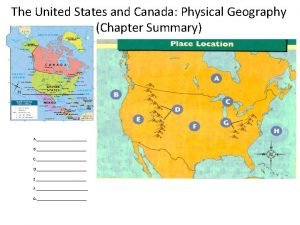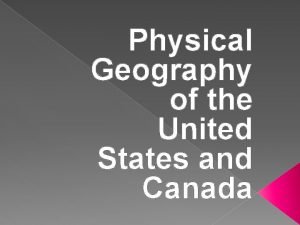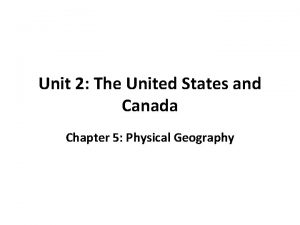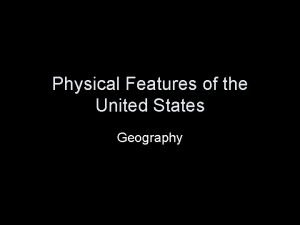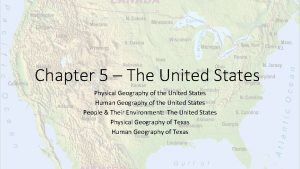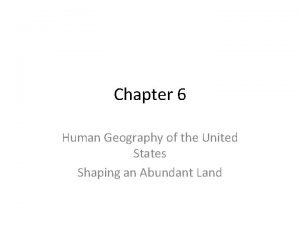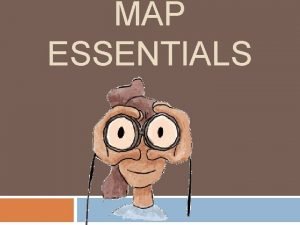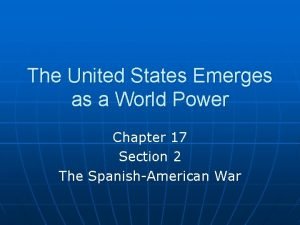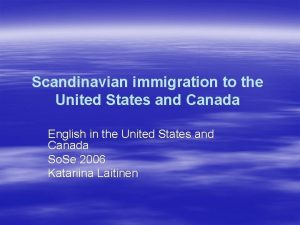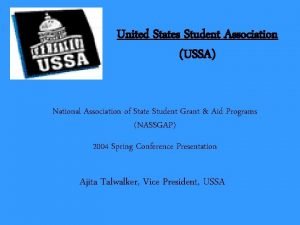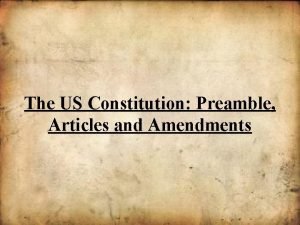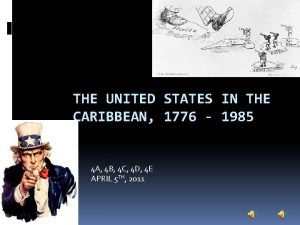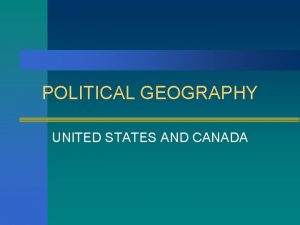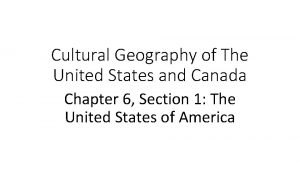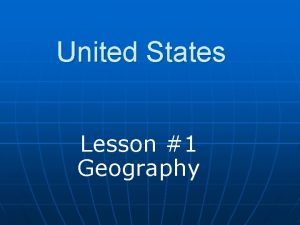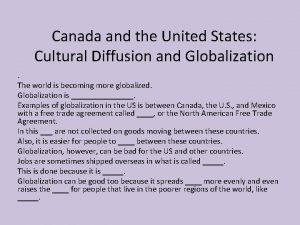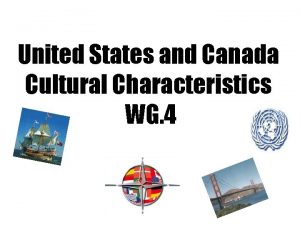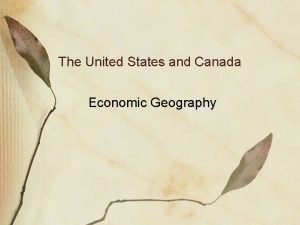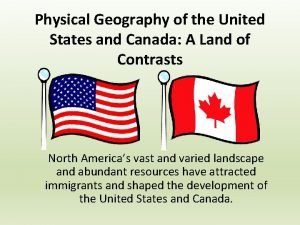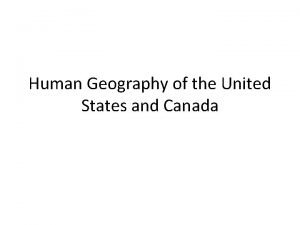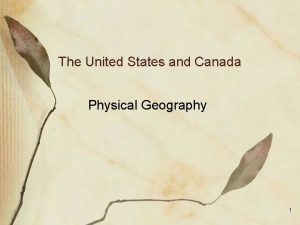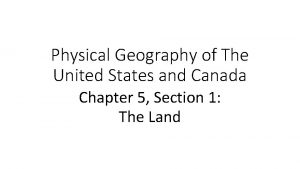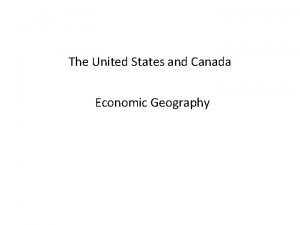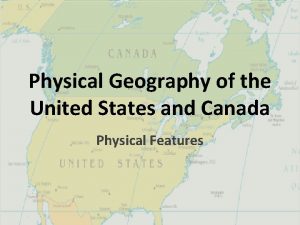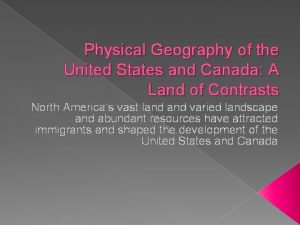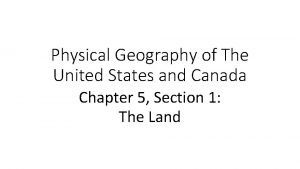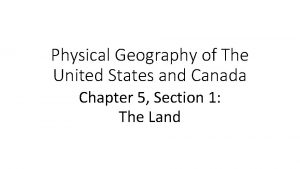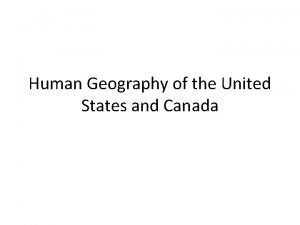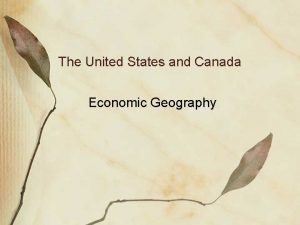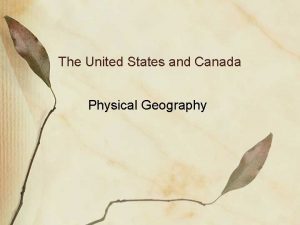Cultural Geography of The United States and Canada
























- Slides: 24

Cultural Geography of The United States and Canada Chapter 6, Section 1: The United States of America

Map of the United States

Stars and Stripes The Grand Union or Washington’s Flag (1775 -1777) Current Flag

Important Vocabulary • Immigration: movement of people from one country to another. • Sunbelt: nickname for the American South and Southwest. • Urbanization: movement of people from rural areas to cities. • Metropolitan Area: a city with a population over 50, 000. • Suburbs: outlying communities from a city. • Urban Sprawl: a suburban development. • Megalopolis: a chain of closely linked metropolitan areas.

Vocabulary (Cont’d) • Underground Railroad: a network of safe houses for escaped slaves. • Dry Farming: a method of preparing land to catch and hold rainwater. • Bilingual: ability to speak two languages. • Literacy Rate: percentage of people who can read and write. • Jazz: blends African rhythms with European harmonies.

The American Population • Diverse population – 12. 5% foreign born (2008). • Over 300 million people in the United States. • First peoples came 20, 000 years ago from Asia. • The population density is 87 people per square mile. • Many people live in warmer climates and the coastal areas.

Colonial America • In the 1700 s, Great Britain controlled the Atlantic coast. • New England, Middle, and Southern Colonies. • The Seven Years War (1756 -1763): Britain obtained French territory.

The American Republic • British taxation and limits on freedom led to the American Revolution (1775 -1783). • U. S. becomes a federal republic. • The Constitution and the Bill of Rights. • Three co-equal branches.

American Growth • Westward expansion and industrialization in the North. • Agriculture (cotton) dominated in the South. • Tensions grew over slavery.

The Union & The Confederacy

The U. S. Civil War • The Union is saved after four years of fighting (1861 -1865). • Slavery is abolished. • The U. S. rebuilds.

Changes & Challenges • Immigrants helped build transcontinental railroads. • The world wars led to American economic growth. • Al-Qaeda terrorists attacked the World Trade Center on September 11, 2001. • Wars in Afghanistan and Iraq.

American Culture • English is the main language. • No state religion. • 99% literacy rate. • Popular entertainment has influenced the world. • The world’s superpower; high living standards. • Married-couple families: 50% of U. S. households.

Cultural Geography of The United States and Canada Chapter 6, Section 2: Canada

Map of Canada

The Maple Leaf National Flag until 1965 Current National Flag

Important Vocabulary • Loyalist: colonists who were loyal to Great Britain. • Province: a political unit similar to a state. • Inuit: arctic native peoples of North America. • Dominion: a partially self-governing country. • Parliament: a national legislature. • Quebecois: Quebec’s French-speaking population. • NAFTA: free North American trade. • Separatism: breaking away to create a separate country.

The Canadian Population • Immigrants came for freedom and opportunity. • Over 90% of Canadians live along the U. S. Canadian border. • The majority live in urban areas. • Population density is 9 people per square mile. • Major cities are: Ottawa(capital), Toronto, Montreal, Vancouver, and Edmonton.

Colonial Canada • England France colonized the land in the late-1600 s. • The Seven Years War (17561763): Britain gains New France. • The 1774 Quebec Act. • Loyalists fled to Canada after the American Revolution. • English and French-speaking communities worked together.

Dominion of Canada • Canada became a dominion in 1867. • “Full” independence in 1931. • Canada is a constitutional monarchy. • 1982 Constitution Act. • Governor-General, Prime Minister, Parliament and a Supreme Court.

Canadian Leaders Prime Minister Justin Trudeau Governor-General David Johnston

Diversity and Growth • Territory expanded and over 1 million immigrants (18151855). • French nationalism in Quebec. • In the 20 th century, industrialization and urban growth. • NAFTA – thriving trade between the U. S. and Canada.

Canadian Culture • English and French Canadian spoken. • Predominately Christian nation. • 99% literacy rate. • Gov’t pays for healthcare.

Culture (Cont’d) • Canadian arts are influenced. Toronto is a major center. • Major sport is hockey. • High living standards. • Married-couple families: 69% of households. • An aging population.
 Does canada have mountains
Does canada have mountains United states and canada physical map
United states and canada physical map Settlement patterns
Settlement patterns Unit 2 the united states and canada worksheet answers
Unit 2 the united states and canada worksheet answers Physical geography usa
Physical geography usa Physical geography of the united states
Physical geography of the united states Why is the united states called a postindustrial economy
Why is the united states called a postindustrial economy What states are west of the mississippi river
What states are west of the mississippi river Awake united states
Awake united states Map of the world with longitude and latitude lines
Map of the world with longitude and latitude lines United states history and government regents
United states history and government regents United states acquisitions and annexations 1857-1904
United states acquisitions and annexations 1857-1904 How many states canada
How many states canada Was the united states on the axis powers or allied powers?
Was the united states on the axis powers or allied powers? Sectionalism map of the united states
Sectionalism map of the united states Us pro soccer
Us pro soccer Marshall case
Marshall case United states student association
United states student association The united states ought to provide a universal basic income
The united states ought to provide a universal basic income Preamble of us constitution
Preamble of us constitution The united states in the caribbean 1776 to 1985
The united states in the caribbean 1776 to 1985 The southeast region of the united states of america
The southeast region of the united states of america Expansion of the united states of america 1607 to 1853 map
Expansion of the united states of america 1607 to 1853 map Why did truman believe greece needed american aid in 1947?
Why did truman believe greece needed american aid in 1947? Gadsden purchase previous owner
Gadsden purchase previous owner
